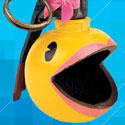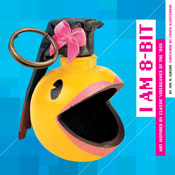
I Am 8-Bit
by Jon M. Gibson
Chronicle

I have to admit feeling weird about reviewing an art book. What makes me qualified to review modern/pop art pieces about ’80s video games? My recent trips to the San Francisco and NYC MoMAs? An adolescence obsessed with comic books? More likely, I think it’s the affinity I share with the creators of this art that first-generation video games had not only a profound cultural impact but a personal one as well. I Am 8-Bit compiles the mixed-media work of 70 international artists along with the occasional insight into the specific inspiration behind the piece.
As both Gibson and foreward author Chuck Klosterman state in their introductory texts, video games are a kind of interactive television, wherein the person playing the game has a much more personal involvement and attachment to the characters they’re controlling than they do when watching television or films. In this light, the art should be taken as the expression of that relationship after time, adulthood and nostalgia have set in. As expected, Pac-Man and the Mario Brothers act as the muses for most of the pieces in this exhibition. They’re in command to such an extent that it’s almost disappointing to note the lack of variation. It leaves me pining for tributes to my neglected favorite games – heavyweights like “Castlevania” and “Contra” and obscure gems like “Bionic Commando.” Ultimately, it’s all forgivable, since what’s present is so good– especially Tim Tomkinson’s gonzo “Duck Hunter S. Thomson,” where the name truly says it all.
What’s most remarkable about the majority of the pieces is the delineation between “cute” and “creepy” that usually got blurred in the games themselves. “Pac-Man’s” ghosts, under the brush of Greg Simkins, become surreal and horrifying, but Anna Chambers’ stuffed “Mario” mushrooms are smiling and adorable. Perhaps the two most telling works come in the form of “Untitled”: one by Peter Gronquist, which features two grenades assembled and painted to resemble Pac-Man and Ms. Pac-Man, and Luke Chueh’s “Dig Dug,” a cartoon-like painting of the hero inflating an enemy to the point of explosion with a bicycle pump, which he calls an “extremely disturbing element” to the game. These takes on dark, absurd and funny forms of violence and surrealism are what seem to have made the deepest impression on these artists. I’m sure the programmers and concept artists of the games that spawned this project are elated and dumbstruck that the weirdness they set forth in the ’80s could have such an affect on the pop art scene of the early 21st century.
Chronicle Books: http://www.chroniclebooks.com












